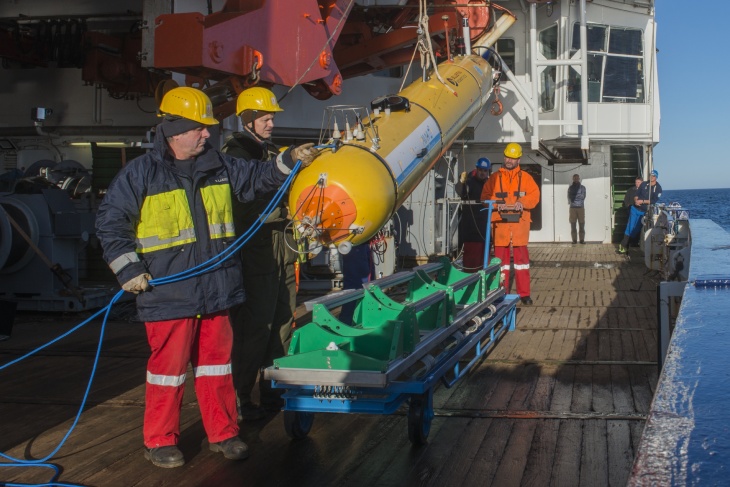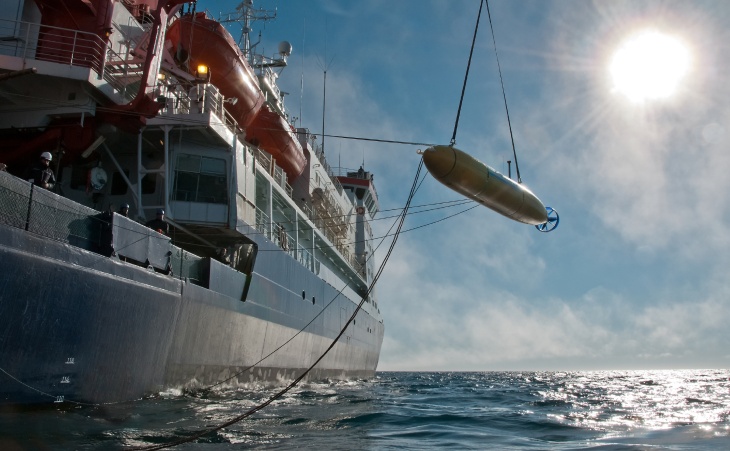Working Together to Bring High Tech Below the Waves
Over the next seven years, the three largest marine research institutes in the Helmholtz Association – the AWI, GEOMAR and Hereon – will pool resources to develop their marine technologies. Their goal: to more quickly and efficiently develop underwater robotic systems, ensuring that research can keep pace with the impacts of climate change, biodiversity loss and pollution.

AUV deployment from Polarstern in Arctic Ocean. Photo: Alfred Wegener Institute / Esther Horvath
Anyone who wants to pursue research on the ocean needs high-tech equipment. Accordingly, underwater vehicles that autonomously glide through the ocean are equipped with a wide range of sensors. Thousands of buoys drift through the ocean. Plus, there are diving robots with cameras and sonar systems, remotely piloted from on board research vessels; and rovers, which survey the seafloor on tyres or caterpillar treads. Despite this cutting-edge arsenal, our understanding of the ocean, deep sea and coasts remains incomplete. In order to assess how the ocean, life within it, and biological, chemical and physical processes are changing in step with climate change and the numerous strains accompanying it, we will need to explore and survey substantially larger ocean regions in the years to come.
Doing so will require cutting-edge technologies and close collaboration. The three largest marine research institutes in the Helmholtz Association – the Alfred Wegener Institute, Helmholtz Centre for Polar and Marine Research (AWI), the Helmholtz-Zentrum Hereon, and the GEOMAR Helmholtz Centre for Ocean Research in Kiel – have now joined forces in the Helmholtz infrastructure MUSE, through which they will jointly develop new research equipment and procedures over the next seven years. MUSE, which stands for Marine Umweltrobotik und -Sensorik für nachhaltige Erforschung (roughly translates to marine environmental robotics and sensors for sustainable exploration) and focuses on the preservation and management of our planet’s coasts, seas and polar regions, will officially start with a kick-off meeting from 23 to 25 May at the AWI in Bremerhaven. Major priorities will include making further strides in sensor technologies, associated software, and the integration of artificial intelligence to help gauge the effectiveness of marine protection measures. “There are experts on these areas at each of the three institutes. Now we’re bringing them together in the first infrastructure project of its kind,” says MUSE Coordinator Martina Löbl from the AWI.

GEOMAR garage lander with crawler Viator. Members of the Helmholtz Alliance ROBEX test the underwater vehicle AWI-Tramper in the basin of the DFKI Bremen. Photo: Alfred-Wegener-Institut / Lars Grübner
Given that the three institutes focus on different geographic areas, the systems they have developed are quite diverse. Hereon contributes its expertise in coastal research, AWI focuses on the ice-covered polar regions, GEOMAR on the blue ocean. “At the same time, there are a range of parameters that are important to all three institutes and their partners – and which will be further developed within an international community through the Global Ocean Observing System,” says Löbl. “Of course, in order for this to work, it has to be possible to easily connect measuring systems to our three institutes’ various underwater vehicles. Consequently, part of the project involves working on a plug-and-play system of sorts.”
MUSE will also standardise data processing among robots, underwater gliders and autonomous vehicles. This will also support field work by making it easier for different systems to cooperate. Then a monitoring system on the seafloor could alert an AUV (autonomous underwater vehicle) if it made an important discovery – so that the AUV could use its on-board sensors to survey the vicinity in more detail. Uniform software standards and algorithms could help make this a reality.

Image from the first field mission of the AWI-AUV on a Polarstern expedition in 2010 to the Fram Strait. Photo: Michael Ginzburg, Alfred-Wegener-Institut
The MUSE project also bears in mind the fact that, around the globe, there is an increasing need for researchers to exchange data and make it available to other working groups. Consequently, a uniform data standard has been developed within the Helmholtz Association over the past several years, intended to facilitate researchers’ access to interesting image data. All MUSE technologies will also satisfy this standard, known as FAIR (findable, accessible, interoperable and reusable).
The Helmholtz Association has allocated 29.7 million euros in funding to establish the Helmholtz infrastructure MUSE as a strategic investment in its further expansion. The project is slated for completion in 2029, at which point the infrastructure will go online. “We’ll initially test the technologies developed using existing underwater vehicles, before deploying them in new models,” says Martina Löbl. Well aware that technologies can change dramatically in the span of seven years, the MUSE team will keep a close eye on the latest advancements and regularly integrate them in their work – so that, when the project ends, they will be able to present cutting-edge solutions.
Further information
Contact
Head of Department
Institute of Carbon Cycles
Phone: +49 (0) 4152 87-2371
